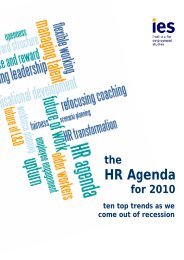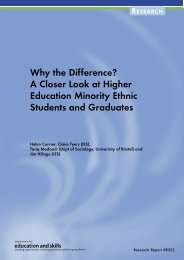Post-16 Transitions: a Longitudinal Study of Young People with ...
Post-16 Transitions: a Longitudinal Study of Young People with ...
Post-16 Transitions: a Longitudinal Study of Young People with ...
You also want an ePaper? Increase the reach of your titles
YUMPU automatically turns print PDFs into web optimized ePapers that Google loves.
Table 5.5: Current main activity, by social group (per cent)<br />
Manager /<br />
pr<strong>of</strong>essional Skilled<br />
Semiskilled<br />
Unskilled<br />
Not in<br />
employment<br />
<strong>Study</strong>ing (school or college) 64 43 36 37 54<br />
Unemployed 7 13 17 19 15<br />
On a Modern Apprenticeship,<br />
National Traineeship, or other<br />
government supported training<br />
6 8 7 4 7<br />
In paid employment 21 31 36 36 14<br />
Working but not getting paid<br />
* * 0 1 *<br />
for it (incl. voluntary work)<br />
Attending a day care centre * * 0 0 *<br />
Looking after the family or<br />
0 1 2 2 4<br />
home<br />
Ill/health problems 1 2 1 1 2<br />
Other 1 2 1 0 2<br />
Total 289 576 193 239 383<br />
Note: All percentages are weighted percentages, unless otherwise stated<br />
* - less than 0.5 per cent<br />
Source: IES/MORI 2003<br />
(particularly those in the semi-skilled or unskilled groups)<br />
were as likely to be in work as they were to be education, and<br />
more likely than young people in the other socio-economic<br />
groups to be unemployed.<br />
Interestingly, young people who could recall having a<br />
transition planning review (and thus plan) were also more<br />
likely to be engaged in some sort <strong>of</strong> positive activity ie<br />
education, training or employment, at the time <strong>of</strong> the survey<br />
(84 per cent compared to 72 per cent overall). <strong>Young</strong> people<br />
<strong>with</strong>out a transition plan were almost twice as likely to be<br />
unemployed as those <strong>with</strong> a transition plan when they were<br />
surveyed (Table 5.6).<br />
The following sections look more closely at the key activity<br />
‘sectors’ in which young people <strong>with</strong> SEN are now engaged.<br />
5.2 Education<br />
5.2.1 Educational establishment<br />
Almost half <strong>of</strong> all young people taking part in the survey were<br />
in education at that time (46 per cent), and the majority <strong>of</strong><br />
these (93 per cent) were studying full-time, regardless <strong>of</strong><br />
gender, ethnicity, SEN type etc.<br />
64 <strong>Post</strong>-<strong>16</strong> <strong>Transitions</strong> <strong>of</strong> <strong>Young</strong> <strong>People</strong> <strong>with</strong> SEN: Wave 2

















